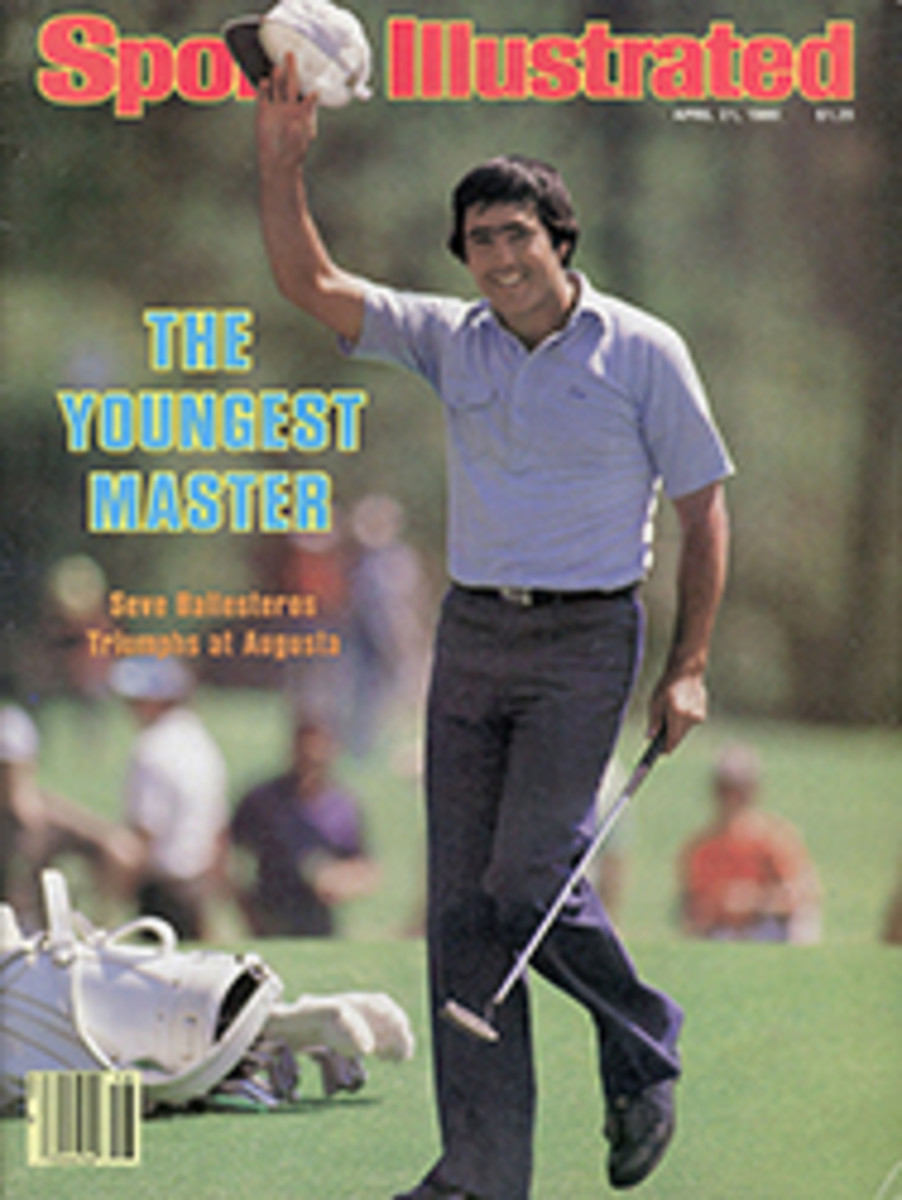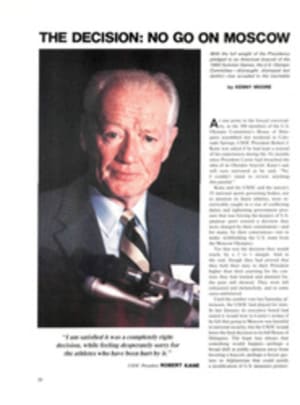
Read you, Roger, wilco and out
As the ice chips settled last weekend following the first leg of the Stanley Cup playoffs, Gordie Howe was heading for retirement; the Atlanta Flames—KO'd by the New York Rangers—were checking out the mortgage rates in Calgary; Scotty Bowman was nursing a large lump on his skull; and Dave (Tiger) Williams, inflictor of said lump, was pleading the Fifth. "I don't know what happened," said Williams, the volatile Vancouver wing who apparently clouted Bowman with the blade of his stick after throwing a vicious but unsuccessful check at Buffalo's Rob Mongrain. "But you know, Scotty is such a good strategy man, he'd try any trick in the book to upset us. Even getting knocked cold."
Nothing so drastic is likely to be found in Bowman's library of game plans, but then again, with Bowman you never know. After coaching Montreal to four straight Stanley Cups, Bowman—miffed because the Canadiens wouldn't give him the vacant general manager's job—went to Buffalo last summer and introduced the Sabres to the concept of multiple coaches, an idea borrowed from football, baseball and European hockey. "When I coached the 1976 Canada Cup team," says Bowman, "I had Don Cherry upstairs, Bobby Kromm on the bench and Al MacNeil scouting. And we won that series on a point Cherry noticed from up top—the Czech goalie came way out of the net on breakaways, and you could beat him by going around him, which is what Darryl Sittler did to get the winning goal in overtime. In hockey, the guy who's busy changing players doesn't see every little thing. Extra coaches who specialize can add so much."
When the Bowman plan is at all-systems-go, Scotty himself patrols the Buffalo bench, matching lines and criticizing and counseling his players, while Associate Coach Roger Neilson watches from the rafters and, by means of a radio hookup, rattles off a stream of information to Assistant Coach Jim Roberts, who wears a headset and works alongside Bowman. The Bowman plan worked wonderfully this season: Buffalo had the NHL's second-best record and won the Vezina Trophy (for yielding the fewest goals) by a wide margin, just as Scotty's Montreal teams had done for four straight years.
"With three coaches, you can control the situation better," says Neilson, who coached the Toronto Maple Leafs singlehandedly from 1977 to 1979. Indeed, in Vancouver Friday night, three coaches proved none too many for the Sabres. Most teams would be shook up if the opposition high-sticked their coach, but Neilson and Roberts merely traded posts until a stitched-up and seething Bowman returned to the bench in the second period. Williams was suspended for one game and played spectator Saturday night as Buffalo beat Vancouver 3-1 to win the series three games to one.
The concept of a coaching staff rather than a lone coach is not altogether new to hockey. Eight years ago Fred Shero, then coaching Philadelphia, made Mike Nykoluk the NHL's first full-time assistant. Nykoluk moved to New York when Shero became the Ranger coach in 1978, and recently the Rangers have added Andre Beaulieu, who briefly coached Minnesota in 1978, as a second assistant. Against Atlanta last week, Nykoluk and Beaulieu made good use of a wireless communications system similar to the Sabres'. The Rangers hadn't beaten the Flames in Madison Square Garden in three years, but they swept both games there and then routed Atlanta 5-2 in Game 4 Saturday night at the Omni to take the series—and probably put an end to NHL hockey in Atlanta.
"When Scotty was in Montreal, sometimes he had Claude Ruel [the current Canadiens coach] in the press box, and they'd talk on the phone between periods," says Neilson. "But when I got here, I felt constant communication would be much more practical. For instance, if I see someone out of position, I can help correct it right away. You've got continual access to stats, and you're always aware of who's coming up in the other team's lineup. So much information is available immediately, using it as it happens can only help."
Neilson got the Motorola Company to devise the special pair of wireless headsets that he and Roberts use during games. "It's like a walkie-talkie, but it's actually a radio," he says. "We even had to get an FCC license for it."
Neilson also is a videotape freak—the Maple Leafs used to call him Captain Video—and every day he spends long hours reviewing replays of games involving the Sabres and most every other NHL team. "Television is a huge advantage in that it eliminates a lot of in-person scouting," he says. "When you haven't seen a team for a while, you review its recent games and try to spot tendencies."
When Neilson came from the Maple Leafs, he brought along statistician Al Dunford to work as his personal videotape man. Dunford edits and splices the clips for Neilson's pregame film festivals. One morning last week Neilson ordered up five-minute segments of Buffalo and Vancouver power-play setups and penalty-killing formations as well as his standard visual scouting report for the team meeting. "Instead of going on the ice and trying to demonstrate what went right or wrong, you take 15 minutes to show it," he says. "And by doing it in this form, players can become more efficient when they get back on the ice."
The indefatigable Neilson also prepares detailed report cards on the Sabres that note, for example, missed chances, bad passes and giveaways. All that paperwork is tedious, but, says Neilson, "That's the beauty of having three coaches. If I had to run practice; splice film, plan strategy and do reports, do you think I'd get it done by noon? I wouldn't get it done by tomorrow night."
Indeed, while Neilson labored over his presentation before Game 2 of the Vancouver series, Bowman, who doubles as Buffalo's general manager, slept late, leaving Roberts in charge of the Sabres' morning skate. Roberts is the team's mother hen. He runs most practice sessions, handles travel arrangements and functions as a buffer between players and coaches. Perhaps because Roberts played the game so recently—he retired in 1978 after 16 seasons in the NHL, including nine under Bowman's coaching—he has a sympathetic ear for players' problems.
With Neilson responsible for game evaluation and preparation and Roberts running practices and leading cheers, Bowman is free to concentrate on what he chooses to. Although Neilson gives the pregame scouting report, Bowman still delivers the game plan. During some practices, Bowman steps in to make points. Behind the bench he is the law. Says Sabre Captain Danny Gare, who scored 53 goals this season, "Scotty is the best coach ever for getting things done in a game. The way he mixes lines, you never relax, because you never know when you're on again."
Next season, though, Bowman plans to concentrate on his non-coaching duties, and Neilson will become the No. 1 man behind the bench. "It shouldn't be any different," Neilson says. "Can you imagine some major company having only one executive in charge? Of course not. It's time hockey people recognized that hockey is a business, too. I'd like to see us have four coaches, maybe even more. There's enough responsibility to go around."
To say the least.
Sabre Wing Craig Ramsay, who played junior hockey for Neilson at Peterborough, Ont., tells about the time when Neilson, a bachelor, called him for advice on a social matter. "Roger had a date with some girl and couldn't decide if he should take her to a junior game or a bantam game," says Ramsay. "It was a real dilemma."
Which is something Buffalo hasn't faced all season. "We have been very, very fortunate," Neilson says. "Not a single injury. Thirteen guys played at least 75 of the 80 games. No adversity. We never lost more than two games in a row, and we did that only once—in December. I wonder how we will hurdle it when things do go down. That's the real test of any team." With three—count 'em, three—coaches, it should be a lot easier to clear.
PHOTO
Perched high above the rink, "Captain Video" Neilson studies the game action and transmits to...
PHOTO
...Roberts and Bowman working the bench.

